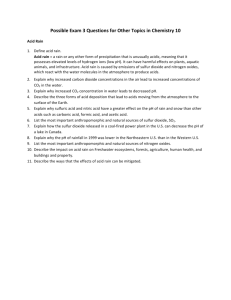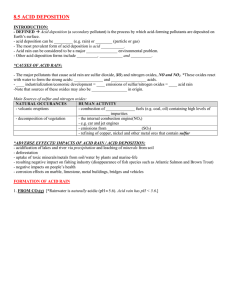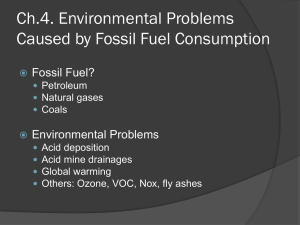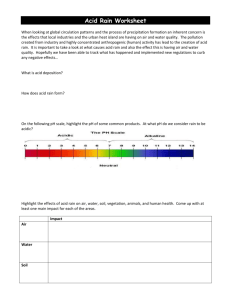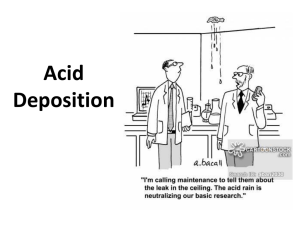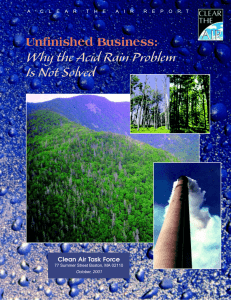The Impact of the Acid Rain Program on Sulfur Dioxide Intensive
advertisement
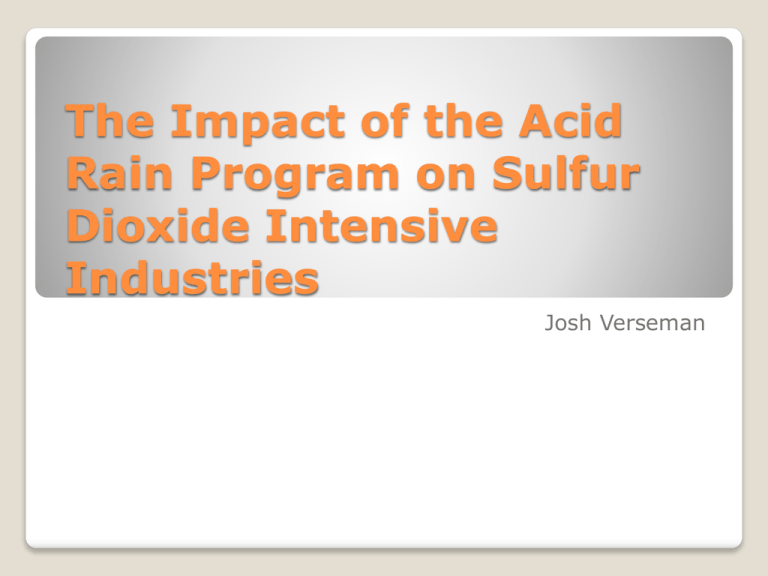
The Impact of the Acid Rain Program on Sulfur Dioxide Intensive Industries Josh Verseman Background Sulfur Dioxide: chemical compound (SO2). Acid Rain: forms when sulfur dioxide particles combine in the atmosphere, creates sulfuric acid. Environmental concern: Affects health (upper respiratory diseases), damages ecosystems due to increased acidity levels, deteriorates historical landmarks, buildings. Major source of SO2 pollution comes from the burning of coal. - Power generation plants are the top polluters Background 1990 Clean Air Act • Congressional effort to improve national ambient air quality standards. • Title IV : Acid Rain Program - Specifically aimed at reducing sulfur dioxide (SO2) levels. - Implements cap-and-trade policy to achieve this SO2 Pollution Rates Nationwide Start of Phase I of the Acid Rain Program http://camddataandmaps.epa.gov/gdm/index.cfm?fuseaction=emissions.prepackaged_select This research examines the potential loss in output that might result from reactionary strategies adopted by firms under the Acid Rain Program. Economic Model •Theory predicts that when marginal costs increase output should decrease • Increase in Abatement Costs -Under the Acid Rain Program a firm has a few options to choose from in order adhere to the pollution restrictions. The abatement costs lead to an increase in marginal costs P INDUSTRY MC₁ MC₀ P₁ P₀ Q₁ Q Q₀ MR D Empirical Strategy •Compare gross domestic product in terms of value added and employment levels of six broadly defined industries before and after the implementation of the Acid Rain Program to capture any loss of output that might occur. Treatment Industries Utilities Manufacturing Mining • Control Industries Retail Professional Business Services, Financial Activities Data come from BEA and BLS -Annual observations between1983-2007 Variables Defined Variable Description Gross domestic product in terms of value GDPVA added by industry in billions of dollars Average yearly number of employees by EMP industry in thousands Dummy variable, 1 if observation is after POST 1995, 0 otherwise Dummy Variable, 1 if an industry is TREAT presumed to be affected (treatment), 0 otherwise (control). POST* Interaction of Post and Treat variables TREAT Average weekly hours per production AHOUR worker per industry Average wage per production worker per AWAGE industry Summary Statistics Industry Means (n=26) Utilities Mining MFG. Retail Variables Business Services Financial Activities GDPVA 174.2 112.7 1,140.9 542.1 844.6 1,532.9 EMP 651.3 713.6 16,517.5 13,786.8 13,250.4 7,073.9 AWAGE 19.0 14.8 12.3 9.1 13.1 12.3 AHOURS 41.3 44.0 40.6 31.3 34.3 36.1 Empirical Model •Equation 1. GDPVA i= β0 + β1POSTi + β2TREATi + β3POST*TREAT+β4EMP + β5AHOURS + β6AWAGE + εit •Equation 2. EMPi= β0 + β1POSTi + β2TREATi + β3POST*TREAT+β4 GDPVA + β5AHOURS + β6AWAGE + εit •β3 is the coefficient of importance -captures change in output measurements for treatment industries relative to the changes that occurred in the control industries. Null Hypothesis H o: β 3 = 0 Alternative Hypothesis HA: β3 ≠ 0 Simplified Difference-in-Difference Example Pre 1995 Levels Post Difference 1995 Levels Treatment Industries Yt1 - Yt2 = ΔYt Control Industries Yc1 - Yc2 = ΔYc Difference ΔΔY = (β3) 12 Results Dependent Variable: GDPVA Adjusted R2 = .61 Observations = 150 Variable Coefficients Std. Error Intercept -5,306.76 .001 10.13 .000 0.07 729.26 -7.27 .040 231.31 116.72 1.98 .000 -1,390.17 188.36 -7.38 .030 -282.91 127.81 -2.21 .000 47.48 12.06 3.93 .000 141.48 19.99 7.08 .000 Employment Post Treatment Post*Treatment Average Earnings Average Hours Week t-Stat P-value Results Dependent Variable: Employment Variable Intercept Adjusted R2 = .74 Observations = 150 Coefficients Std. Error t-Stat P-value 66,792.67 4,860.63 13.74 .000 5.61 0.55 10.13 .000 2,729.82 1,000.46 2.73 .007 14,538.35 1,485.84 9.78 .000 Post*Treatment -124.65 1,127.35 -0.11 .91 Average Earnings -695.36 93.03 -7.43 .000 -1,612.56 149.78 -10.77 .000 GDPVA Post Treatment Average Hours Week Conclusions •Analysis indicates mixed results. - Able to reject null hypothesis and conclude that there is a correlation between implementation of the Acid Rain Program and a decease in gross domestic product. -In terms of employment, fail to reject null hypothesis. Conclude that the Acid Rain Program did not affect employment levels. •Further research could examine the discrepancy between the two outcomes Wet Sulfate Deposition 1989-1991 Source: National Atmospheric Deposition Program, 2007 http://www.epa.gov/eroeweb1/pdf/roe_hd_layout_508.pdf Wet Sulfate Deposition 2004-2006 Source: National Atmospheric Deposition Program, 2007 http://www.epa.gov/eroeweb1/pdf/roe_hd_layout_508.pdf Wet Sulfate Deposition 1989-1991 2004-2006 Source: National Atmospheric Deposition Program, 2007 http://www.epa.gov/eroeweb1/pdf/roe_hd_layout_508.pdf


